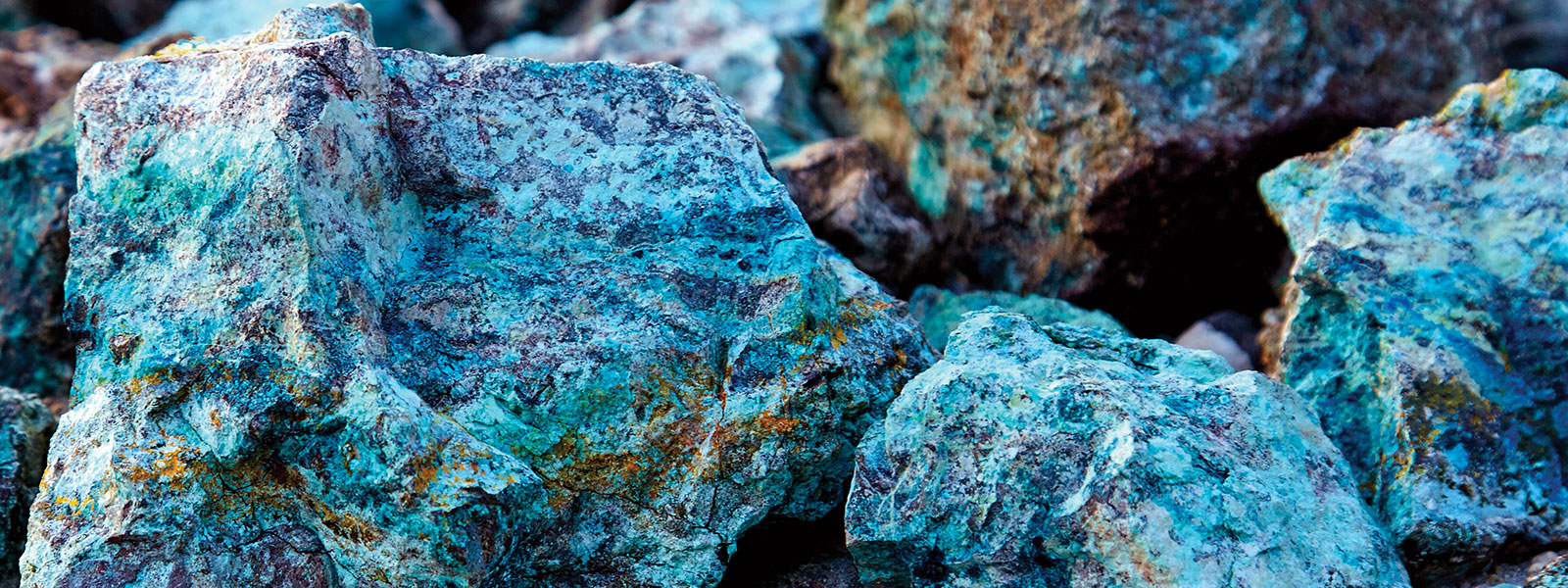
Mining & metals in the COVID-19 world: Underlying resilience masks ESG concerns
The global mining & metals industry began the new decade on a positive note. But as the global economy is struck by the unprecedented force of the coronavirus pandemic, how is the sector positioned for life post-COVID-19?
14 min read
While the pandemic was obviously an unexpected shock, the mining industry had better prepared balance sheets to lean on in a way many other sectors did not
US$ 2,000
Projected price per ounce of gold over the next 12 months.Source: Goldman Sachs
After an encouraging start to the year, the global economy has been struck by the unprecedented force of the coronavirus pandemic. Given most mineral commodities' dependence on global growth, combined with mine-level shutdowns and the sector's reliance on functioning global supply chains to bring products to market, much of the mining & metals space was hard hit early on. However, what should we expect heading into the second half of the year? In this special mid-year survey, we asked mining & metals industry participants to share their views on how the sector is positioned for the COVID-19 "new normal".
The global mining & metals sector began the new decade on a positive note. After more than a year of negotiations, the US and Chinese governments signed a preliminary deal to ease the simmering trade tensions that had threatened to derail global growth, and the fundamentals of the industry remained strong. Record amounts of capital were being distributed back to shareholders and there was a real sense the industry was serious about improving its ESG performance following a significant ramp up of pressure from investors.
Then came the COVID-19 pandemic, which went from being a China problem in January, to an Asian problem in February, to a global issue since March. The world's economy was effectively put on ice, with one-third of the planet’s population placed in some form of lockdown to contain the spread of the virus. Miners came under severe pressure as demand for raw materials—particularly, in the early stages of the pandemic, from China— stalled, with no real history to guide investors to the future with any real degree of confidence.
This has left the industry at an uncertain juncture at the mid-point of the year. Companies clearly need to prepare themselves for this "new normal," but what does this mean for the ESG ambitions that appeared to have real momentum as we began the year? To get an idea of what to expect and learn more about how investors' mindsets changed compared with the start of 2020, White & Case has conducted a special mid-year survey of industry participants, with a record 67 senior decision makers providing us with their thoughts on the remainder of the year.
Responses to our survey illustrate the sheer scale of the shock to the market, and how COVID-19 has impacted investor expectations. While 39 percent cite global market weakness as their biggest concern, trade tensions—which had been deemed the biggest risk in January— has dropped from 26 percent to just five percent. While the US and Chinese governments have signed a preliminary deal, much of this was widely anticipated toward the end of 2019, with our respondents expecting tensions to drag as the two countries worked their way through a "phase two" deal in an election year.
A similarly dramatic decline was seen in the proportion of those selecting a slowdown in the Chinese economy—consumer of about half of the world's commodities—as the biggest risk. Just five percent see this as the biggest concern, down from 24 percent in January, and even higher in 2019, when it polled as the biggest risk. Perhaps the fact that China appears to have been first in to the crisis and first out, coupled with Beijing's appetite to spend its way out of slowing growth, is behind this reading. Several major provinces have cumulatively announced plans to build or restart approximately 25 trillion yuan (US$3.6 trillion) of infrastructure projects in the coming years, with 3.5 trillion yuan in 2020 alone.
The big diversified miners entered 2020 in the best shape they’ve been for years with record amounts of money being returned to shareholders through dividends and buybacks
The big miners
The big diversified miners entered 2020 in the best shape they've been in for many years. Following the crisis in 2015, when Chinese demand slowed, plummeting the debt-laden industry into chaos, miners learned a harsh lesson and significantly changed their practices. Growth projects have been smaller, while funding has been structured in a way that is less onerous on even the biggest balance sheets.
Non-core assets have been sold, debt heavily reduced and by 2019 record amounts of money were being returned to shareholders through dividends and buybacks. While the pandemic was obviously an unexpected shock, the industry had better prepared balance sheets and recent experience to lean on in a way many other sectors did not.
As soon as COVID-19 spread globally, several mines around the world were forced to slow or temporarily close as governments sought to contain the spread of the virus. The big two, Rio and BHP, announced plans to review or lower capital spending, halting development projects to maximize cash, while Glencore reduced its capex forecast for the year by up to US$1.5 billion. These actions mirror the thoughts of our respondents, with more than a quarter stating that building resilience would be the main priority for the sector in the second half, with efficiencies second at 18 percent.
US$ 3.6tn
Several major provinces In China announced plans to build or restart approximately US$3.6 trillion of infrastructure projects in the coming years
A return of the generalist investor?
In addition to this swift action, the world's biggest miners have been comparatively unscathed by the pandemic, given demand from China has held up and the most important mines continued to operate. Perhaps this explains why only 13 percent of respondents expect generalist investors to remain wary of the sector, down from 36 percent at the beginning of the year. The lure of shareholder returns in an uncertain market may tempt the generalists in, and our survey shows exposure to the battery minerals supply chain is expected to be a significant factor, doubling from January to 18 percent in June.
However, responses to this question also hint at some of the underlying tension that exists in the sector. Some 14 percent expect improved ESG performance to lure generalist investors to allocate capital to the sector, up from nine percent in January. A stunning 80 percent think ESG will play a greater part in investors' decision making, too. Yet 65 percent expect long-term sustainability initiatives to conflict with the need to cut costs, and this is borne out in the questions discussed above, with responses considering ESG to be a main priority for the sector, halving from 26 percent to 13 percent. Just two percent think shareholder activism is a key risk this year, down from 13 percent in January, after a year in which climate change started to gain real traction and have a direct impact on the way the biggest miners operate.
Only time will tell whether this tension will manifest itself in reality, or whether the industry will keep ESG near the top of the agenda. It is clear that although shareholder returns are clearly crucial to attracting investors, ESG remains an important driver. In addition, 22 percent of respondents to our survey see ESG as a means of building greater resilience for the future, second only to supply chain excellence. 2019 also demonstrated to miners that—in contrast to the global macro considerations—they are in much greater control of what they can do to adapt to this environmental challenge, and improve their reputation as a result.
Anglo American became the latest example of miners steering away from thermal coal, the most polluting fuel, announcing in May 2020 that it plans to exit its biggest coal business within the next three years, providing a clear roadmap on how it will stop mining the fuel. There are also some that suggest the pandemic could ultimately aid the energy transition by providing a platform from which to develop a green recovery. Our respondents are undecided on this, with an even split on whether the oil price decline will impact the sector's drive to renewable sources of power.
Increased taxation is seen as the way resource nationalism is most likely to manifest itself in the wake of COVID-19
Resource nationalism
The impact miners can have on local communities has long been a source of tension. In our survey, Africa is the anticipated hotspot for resource nationalism, with half of respondents expecting the continent to account for the most action, up from 44 percent in January; notably, South East Asia dropped to nine percent from 25 percent, perhaps due to Indonesia's parliament recently approving significant changes to the country's mining laws. The government can now hand out longer-term contracts to companies promising significant investment in the country, which is the world's biggest nickel and copper producer. That cleared up the uncertainty from 2019 when the government banned nickel exports, roiling the market.
Almost half of respondents see increased taxation as the way resource nationalism is most likely to manifest itself in the wake of COVID-19. Countries certainly recognize the need for miners to help reinvigorate the economy. With that in mind, states are arguably less likely to take action that drives investors away, such as direct expropriation, but there is a very real risk that higher taxes will be the method of choice as governments look to capitalize on industries able to get restarted quickly.
80%
Of our respondents think ESG will play a greater part in investors' decision making
Source: White & Case extraordinary COVID-19 mid-year mining & metals survey, 2020
While higher taxation is the greatest risk, direct—and very public—flare-ups can already be seen occurring in copper hotspot Zambia, which threatened to strip Glencore of its mining license in April in response to the company closing a key mine because of weak prices, disrupted logistics and travel restrictions imposed due to the virus. The mines minister even called on workers to rise up against Glencore, according to local media. Zambia's government is notoriously aggressive with miners, as Glencore has previously found in addition to Vedanta, who saw its local unit placed into administration by the government in 2019 after it was accused of underpaying taxes. In our survey, 75 percent anticipate an increase in government enforcement, similar to January, but 40 percent expect Africa to see the largest amount, up from 15 percent at the start of the year. Such is the importance of mining to many African countries—with fewer levers to pull during a global recession—they simply cannot afford to lose a core revenue stream at a time of macro uncertainty, which may tempt them towards more nationalistic behavior.
Precious metals, and the companies that mined them, have been the standout performers of the year so far
Big deals
Outside of the gold space, the mining & metals industry has seen few transformative deals in recent years as the industry focused on getting leaner, while investors seem to have little appetite to return to the seismic M&A of the past. Major deals will still happen—such as the combination of Metso's minerals business with Outotec, which completed at the end of June—but such transactions are likely to be fewer and farther between. In addition, there are now far greater logistical challenges to completing a deal in the current climate, given potential buyers will struggle to visit an asset.
Our survey suggests this theme is set to continue, with one-third expecting distressed M&A to be on the agenda as the economic slowdown forces deals, while a further third expect deals to be opportunistic over the rest of the year. Precious metals is where our respondents think activity is most likely, attracting 49 percent of the vote, up from 30 percent at the start of the year. Notably, base metals has declined to six percent from 33 percent, with battery minerals rising one place into second.
When it comes to how such deals could be financed, our survey suggests there may be a reduction in the use of bonds and an increase in streaming/alternative financing methods. The majority of other responses mirrored January's survey.
Precious metals, and the companies that mined them, have been the standout performers of the year. After a positive 2019, the global economy freezing earlier this year helped drive bullion up above US$1,750/oz and close to the highs seen at the start of the last decade. For the gold miners, not only are they more able to execute deals, but are in greater demand as investors source exposure to the metal. In June 2020, Zijin Mining agreed to buy Guyana Goldfields to expand its mining portfolio, and South Africa's top gold miner, Harmony Gold, agreed to purchase AngloGold Ashanti’s operations in the country.
The picture could improve further for the sector. Continuing concerns about lockdowns and damage to the real economy should keep demand strong; central banks, for example, purchased nearly six million ounces of the metal this year through April, according to the IMF. Goldman Sachs predicts bullion could reach US$2,000/oz over the next year, especially if the US Federal Reserve tolerates above-target inflation should the job market surprise to the upside. Given fairly stable all-in-production costs, the lure of each dollar increase translating into profit is bringing previously marginal mines back into play as viable assets, so interest in the sector can be expected to remain very strong.
49%
Of our respondents expect precious metals to see most of the M&A activity for the sectorSource: White & Case extraordinary COVID-19 mid-year mining & metals survey, 2020
Outperformers
The positive sentiment surrounding precious metals deals is also reflected in our survey when it comes to picking the metals expected to recover quickest following COVID-19, with 33 percent choosing gold, up from 22 percent when respondents selected their pick in January to outperform over the year. Copper was the most popular choice, polling 39 percent, up slightly from January. However, battery materials continue to remain under pressure, with only eight percent picking lithium, down from 14 percent at the start of the year.
After a dramatic slump in the first three months of the year when the copper price fell by almost 30 percent, the bounce back has been almost as swift with China's copper smelters ramping up output in April and May as economic activity recovered. Iron ore has also risen sharply in the face of returning Chinese demand for steel, touching US$100/ton in June. This flies in the face of the concerns earlier in the year, when waning Chinese steel demand during the Chinese peak of COVID-19 initially led to concerns of a surplus of ore, prompting consensus forecasts that pointed to prices slipping for the year. Our respondents also remain unsure of the prospects for iron ore, with just 10 percent picking it as their top choice.
The specter of further waves of infections is undoubtedly the elephant in the room regarding coronavirus. This is the most significant factor that will determine whether this apparently swift recovery can be sustained. If so, the mining & metals sector should benefit, having proven itself to be resilient with markedly improved balance sheets following the downturn that engulfed the industry since 2015. If this does prove to be a V-shaped recovery (rather than a wobbly revival hampered by further waves of infection or, in the worst case, a prolonged downturn), the momentum at the turn of 2020 that appeared to be behind a more sustainable future for the sector should be maintained. However, the relative importance of the ESG agenda for the sector in the medium term has clearly been called into question by the impact of coronavirus and the global economic downturn. As yet, it is unclear what sector stakeholders—including investors, customers, communities and governments—will demand of the industry during the global recovery, and whether the industry will be able to build on the considerable progress made in recent years in ESG matters while simultaneously managing all of the other pressures brought about by coronavirus and the global economic downturn.
This publication is provided for your convenience and does not constitute legal advice. This publication is protected by copyright.
© 2020 White & Case LLP

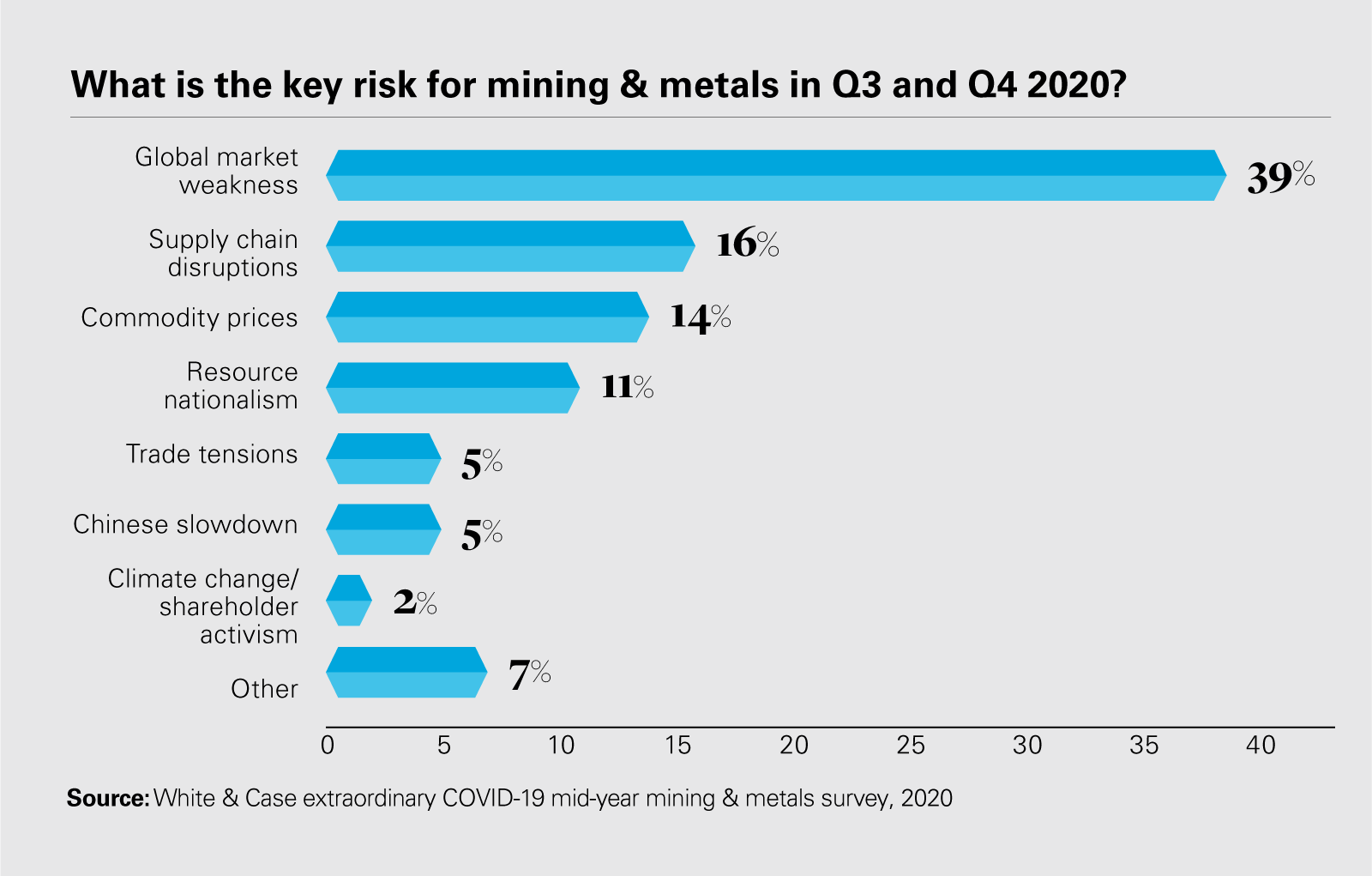 What is the key risk for mining & metals in Q3 and Q4 2020? (PDF)
What is the key risk for mining & metals in Q3 and Q4 2020? (PDF)
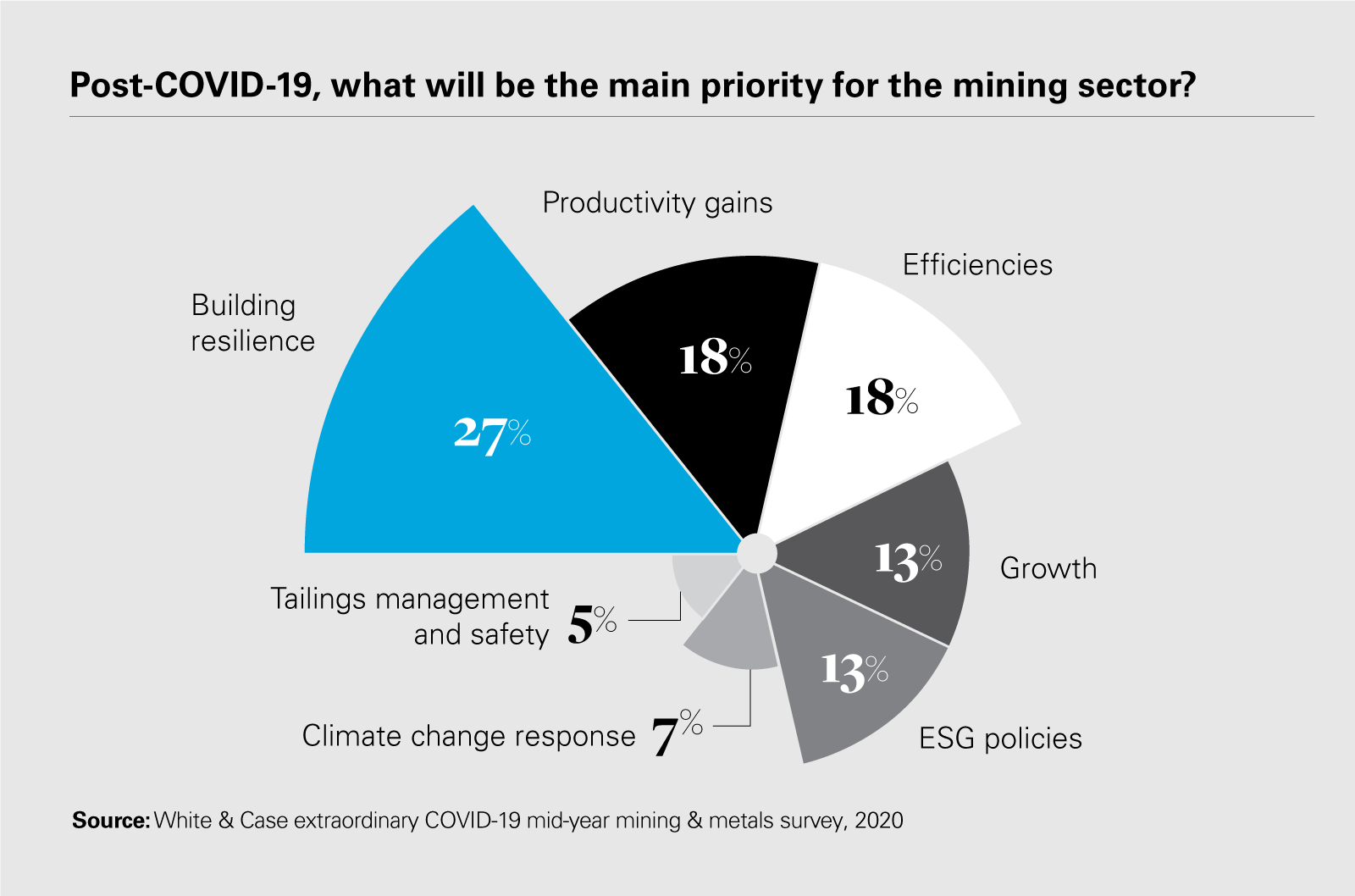 Post-COVID-19, what will be the main priority for the mining sector? (PDF)
Post-COVID-19, what will be the main priority for the mining sector? (PDF)
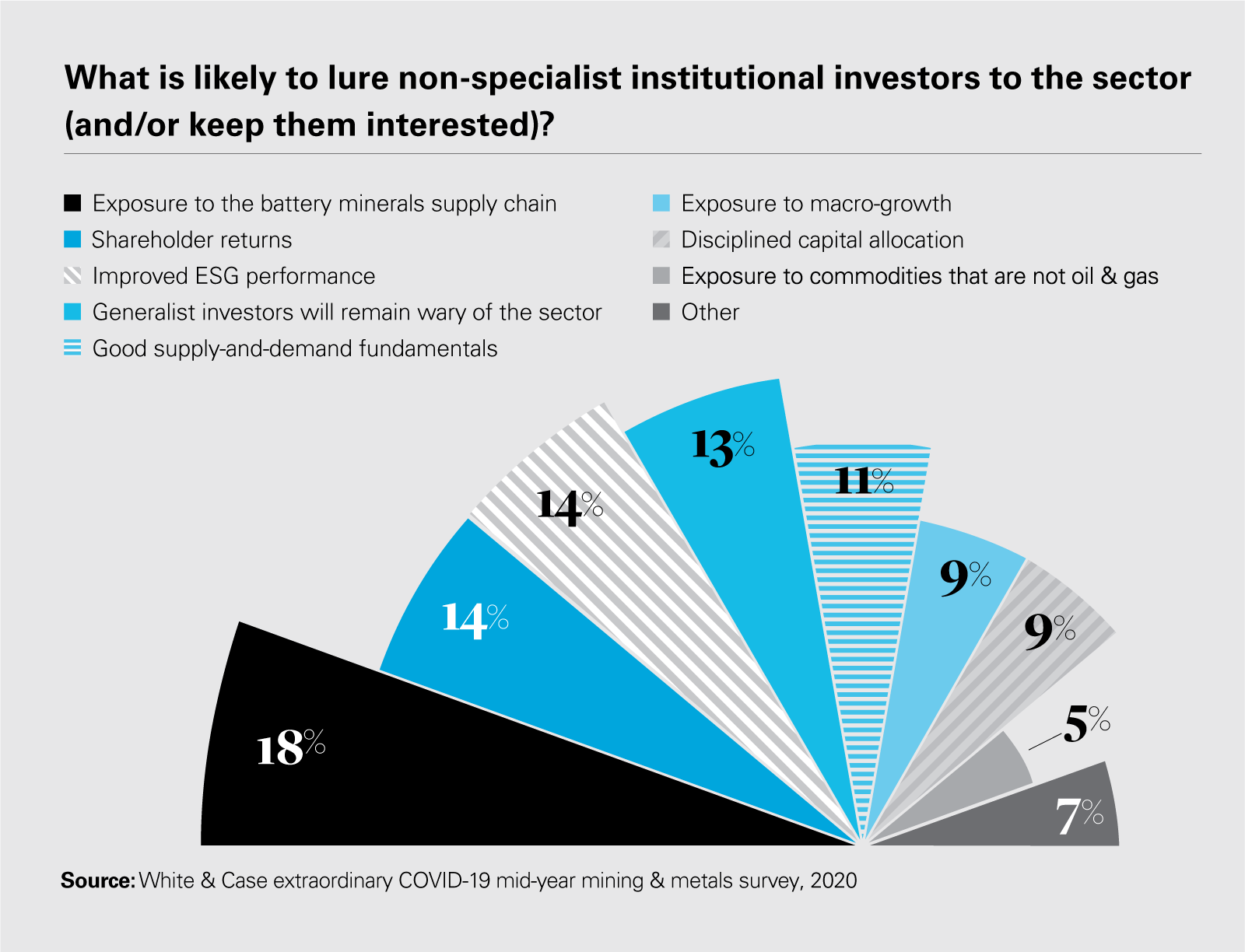 What is likely to lure non-specialist institutional investors to the sector (and/or keep them interested)? (PDF)
What is likely to lure non-specialist institutional investors to the sector (and/or keep them interested)? (PDF)
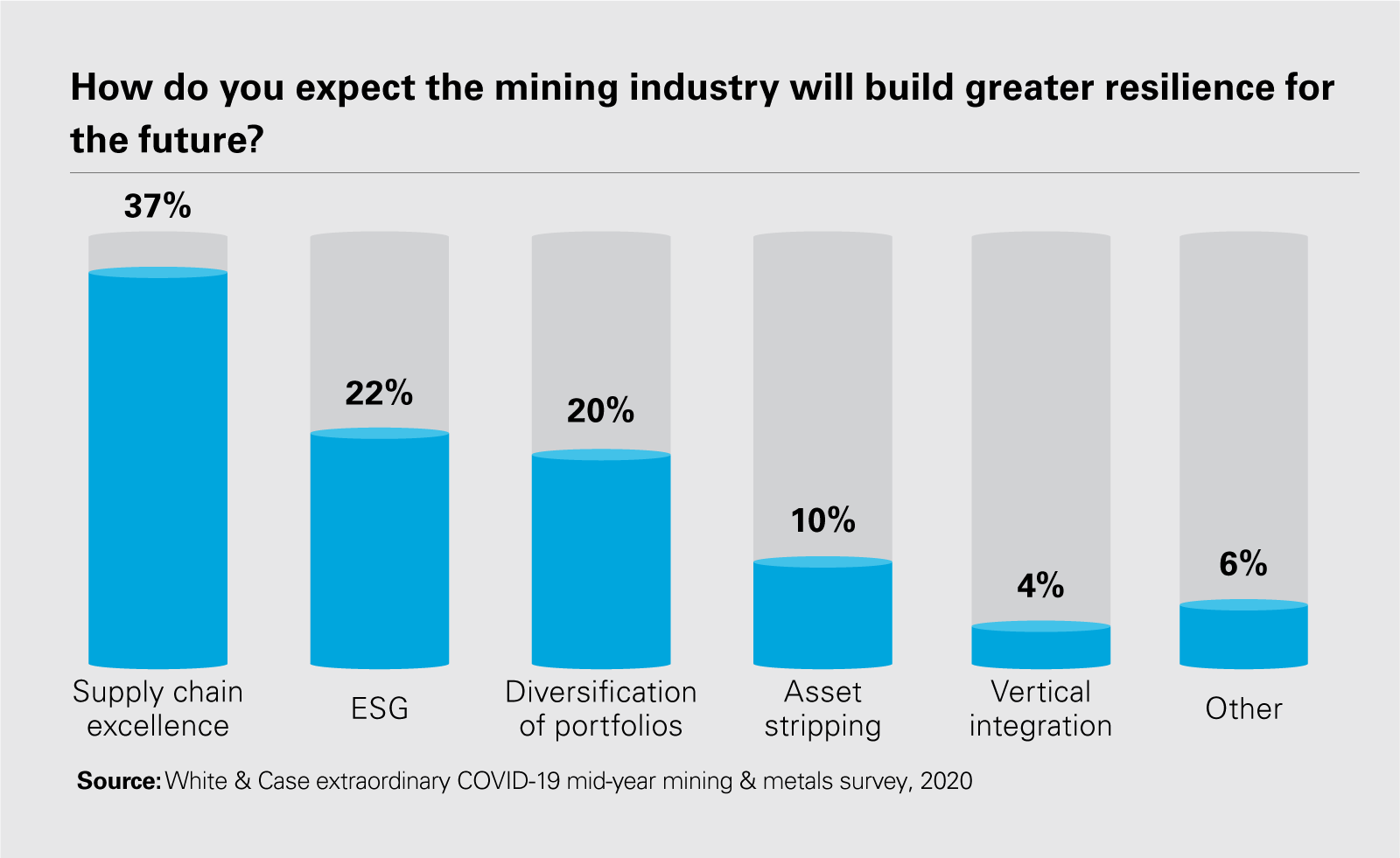 How do you expect the mining industry will build greater resilience for the future? (PDF)
How do you expect the mining industry will build greater resilience for the future? (PDF)
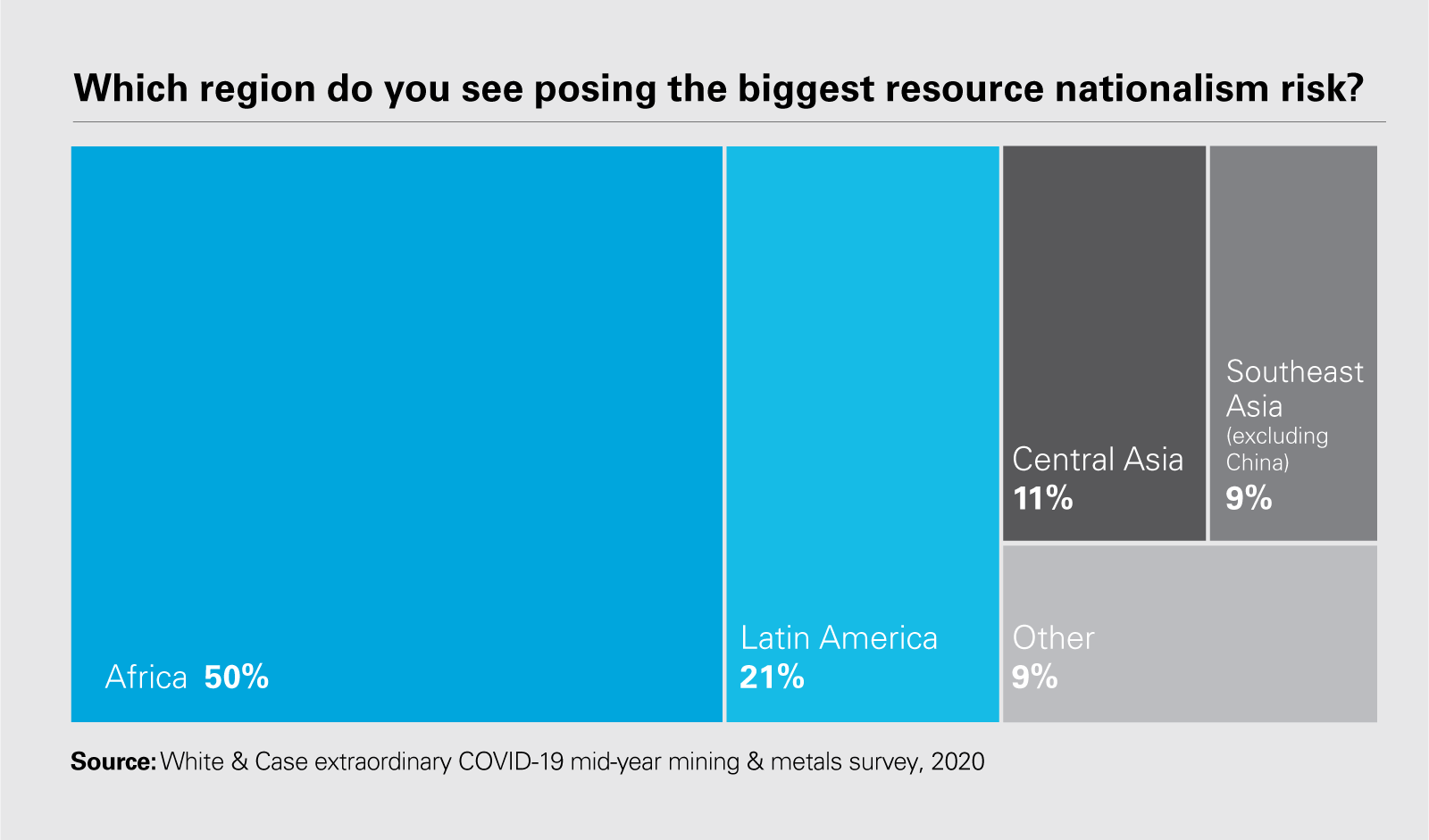 Which region do you see posing the biggest resource nationalism risk? (PDF)
Which region do you see posing the biggest resource nationalism risk? (PDF)
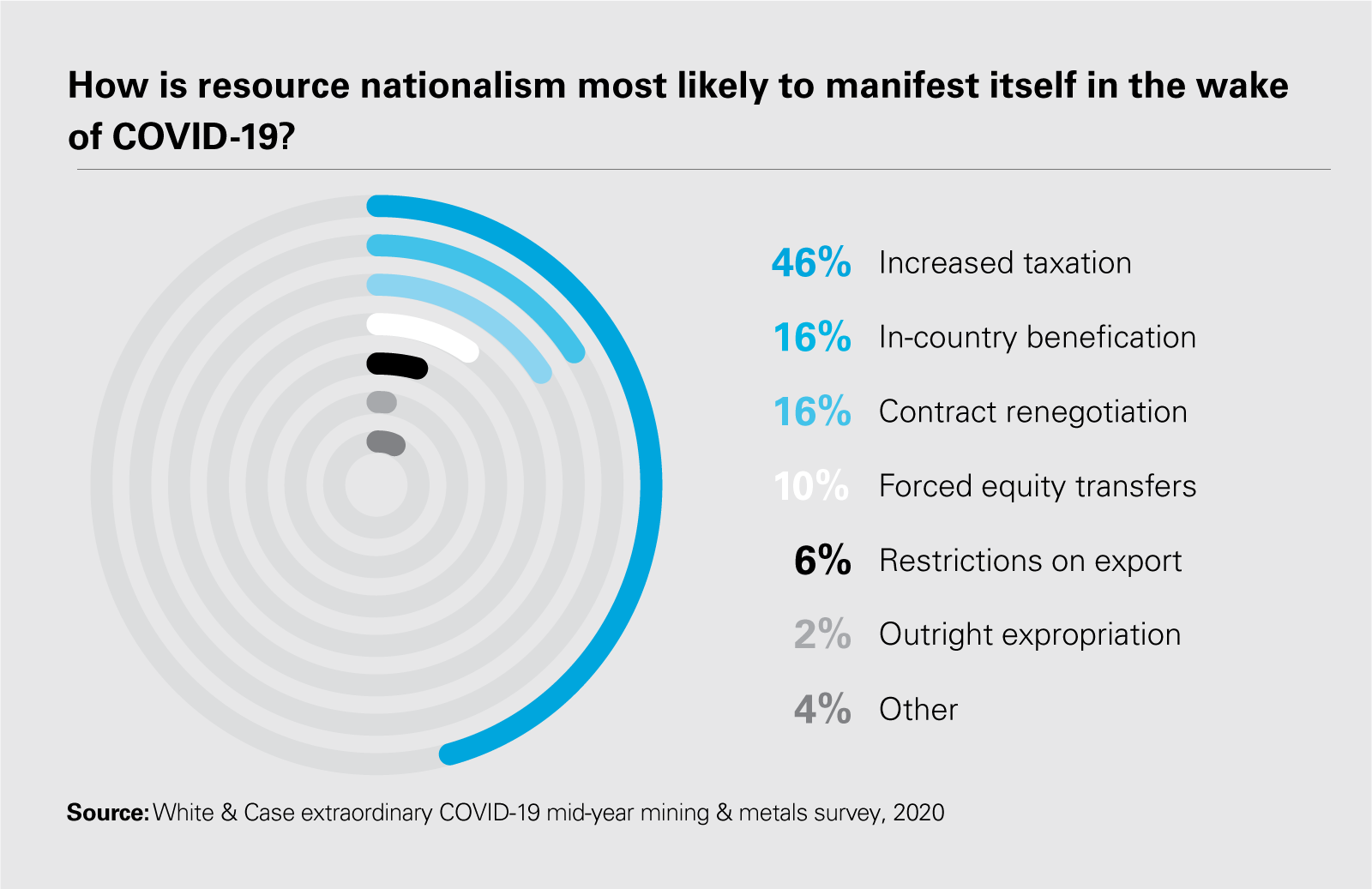 How is resource nationalism most likely to manifest itself in the wake of COVID-19? (PDF)
How is resource nationalism most likely to manifest itself in the wake of COVID-19? (PDF)
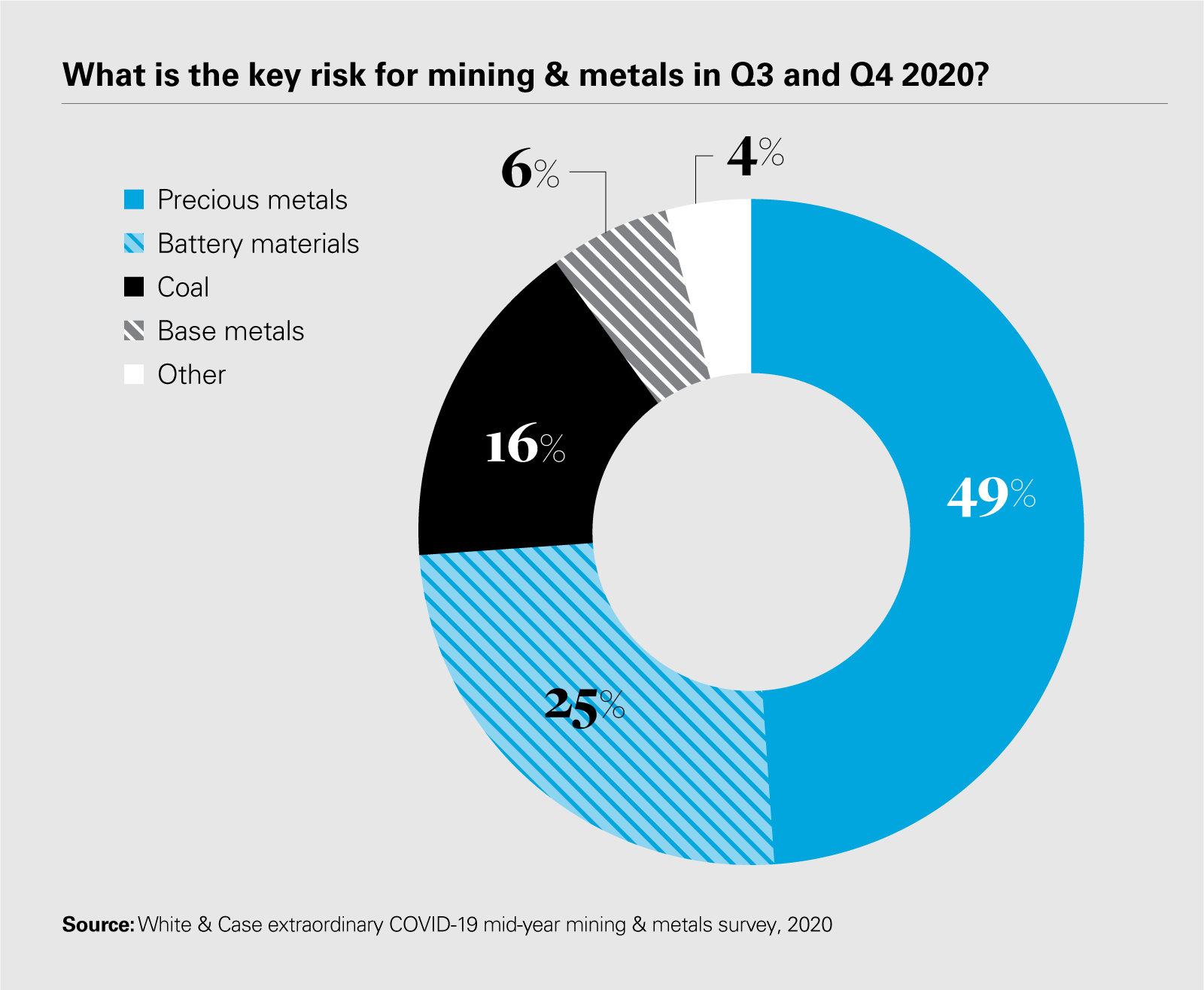 What is the key risk for mining & metals in Q3 and Q4 2020? (PDF)
What is the key risk for mining & metals in Q3 and Q4 2020? (PDF)
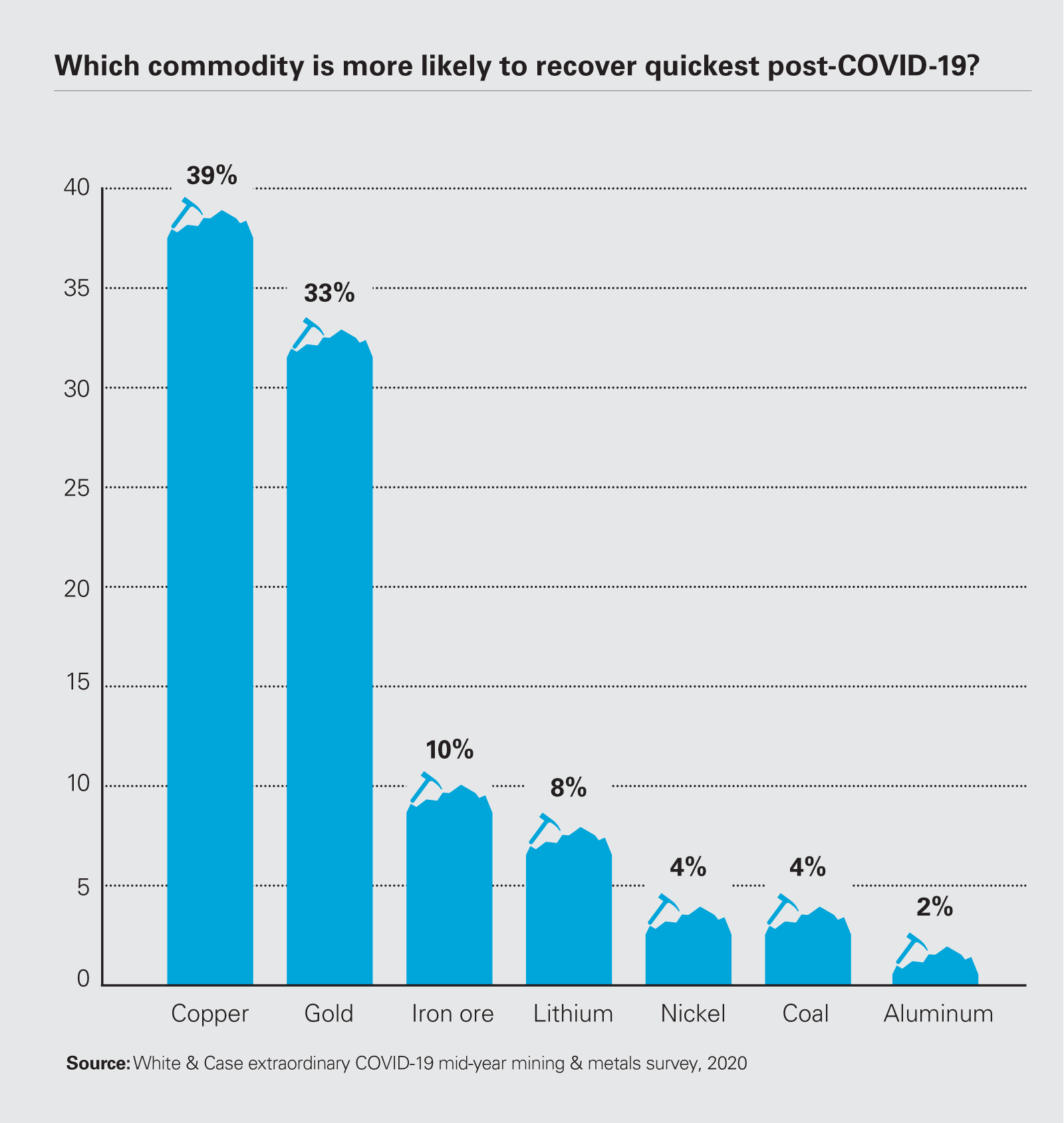 Which commodity is more likely to recover quickest post-COVID-19? (PDF)
Which commodity is more likely to recover quickest post-COVID-19? (PDF)

